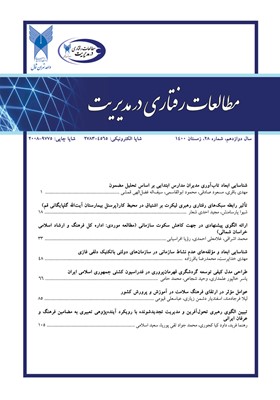تبیین ابعاد و مولفه های مدل بهرهوری مدیران آموزش و پرورش استان لرستان؛ یک رویکرد آمیخته
محورهای موضوعی : مطالعات رفتاری در مدیریتحجت فلاحپور 1 , ابراهیم پورحسینی 2 , شجاع عربان 3
1 - گروه مدیریت آموزشی، واحد خرم آباد، دانشگاه آزاد اسلامی، خرم آباد، ایران
2 - گروه مدیریت آموزشی، واحد خرم آباد، دانشگاه آزاد اسلامی، خرم آباد، ایران
3 - گروه علوم تربیتی، پردیس علامه طباطبایی
کلید واژه:
چکیده مقاله :
پژوهش حاضر با هدف تبیین ابعاد و مولفه های مدل بهرهوری مدیران آموزش و پرورش استان لرستان انجام شد. روش تحقیق تلفیقی (کیفی- کمّی) و از نظر هدف کاربردی بود. جامعه آماری در مرحه کیفی شامل 12 نفر از خبرگان و در مرحله کمّی کلیه مدیران مدارس دوره دوم متوسطه آموزش و پرورش استان لرستان به تعداد 411 نفر بودند. برای تعیین حجم نمونه کیفی از روش اشباع نظری و در بخش کمّی، از جدول کرجسی- مورگان تعداد 199 نفر (102 مرد و 97 زن) به عنوان نمونه آماری تعیین و با روش نمونهگیری تصادفی خوشهای انتخاب شدند. ابزار پژوهش پرسشنامه محقق ساختهای بود که اعتبار آن توسط اساتید و پایایی آن با آزمون آلفای کرونباخ بررسی و مقدار 82/0 به دست آمد. برای تجزیه و تحلیل دادهها نیز از نرم افزارهای Spss26 و معادلات ساختاری lisrel استفاده شد. نتایج بخش کیفی با پانل دلفی نشان داد هفت مؤلفه عوامل انگیزشی، عوامل مدیریتی، عوامل محیطی، عوامل توانمندسازی، عوامل مقبولیت، عوامل نوآوری و عوامل سازمانی و 62 شاخص برای بهرهوری مدیران شناسایی شد. نتایج معادلات ساختاری نیز نشان داد بارعاملی عوامل انگیزشی 84/0، عوامل مدیریتی 79/0، عوامل محیطی 80/0، عوامل توانمندسازی 72/0، عوامل مقبولیت 83/0، عوامل نوآوری 69/0 و عوامل سازمانی 85/0 هستند. همچنین تمام شاخصهای برآورد مدل اندازهگیری نشان از برازش مناسب مدل بودند.
The aim of this study was to identify the factors affecting the productivity model of education managers in Lorestan province. The research method was integrated (qualitative-quantitative) and applied in terms of purpose. The statistical population in the qualitative stage included 12 experts and in the quantitative stage all the principals of the secondary schools of Lorestan province were 411 people. To determine the qualitative sample size by theoretical saturation method and in the quantitative part, from Krejcie-Morgan table, 199 people (102 men and 97 women) were selected as a statistical sample and selected by cluster random sampling method. The research instrument was a researcher-made questionnaire whose validity was assessed by professors and its reliability was assessed by Cronbach's alpha test and the value was 0.82. Spss26 software and lisrel structural equations were used for data analysis. The results of the qualitative section with Delphi panel showed that seven components of motivational factors, managerial factors, environmental factors, empowerment factors, acceptance factors, innovation factors and organizational factors and 62 indicators for managers' productivity were identified. The results of structural equations also showed that the factor load is motivational factors 0.84, managerial factors 0.79, environmental factors 0.80, empowerment factors 0.72, acceptance factors 0.83, innovation factors 0.69 and organizational factors 0.85. Also, all the estimation indicators of the measurement model indicated a good fit of the model.

